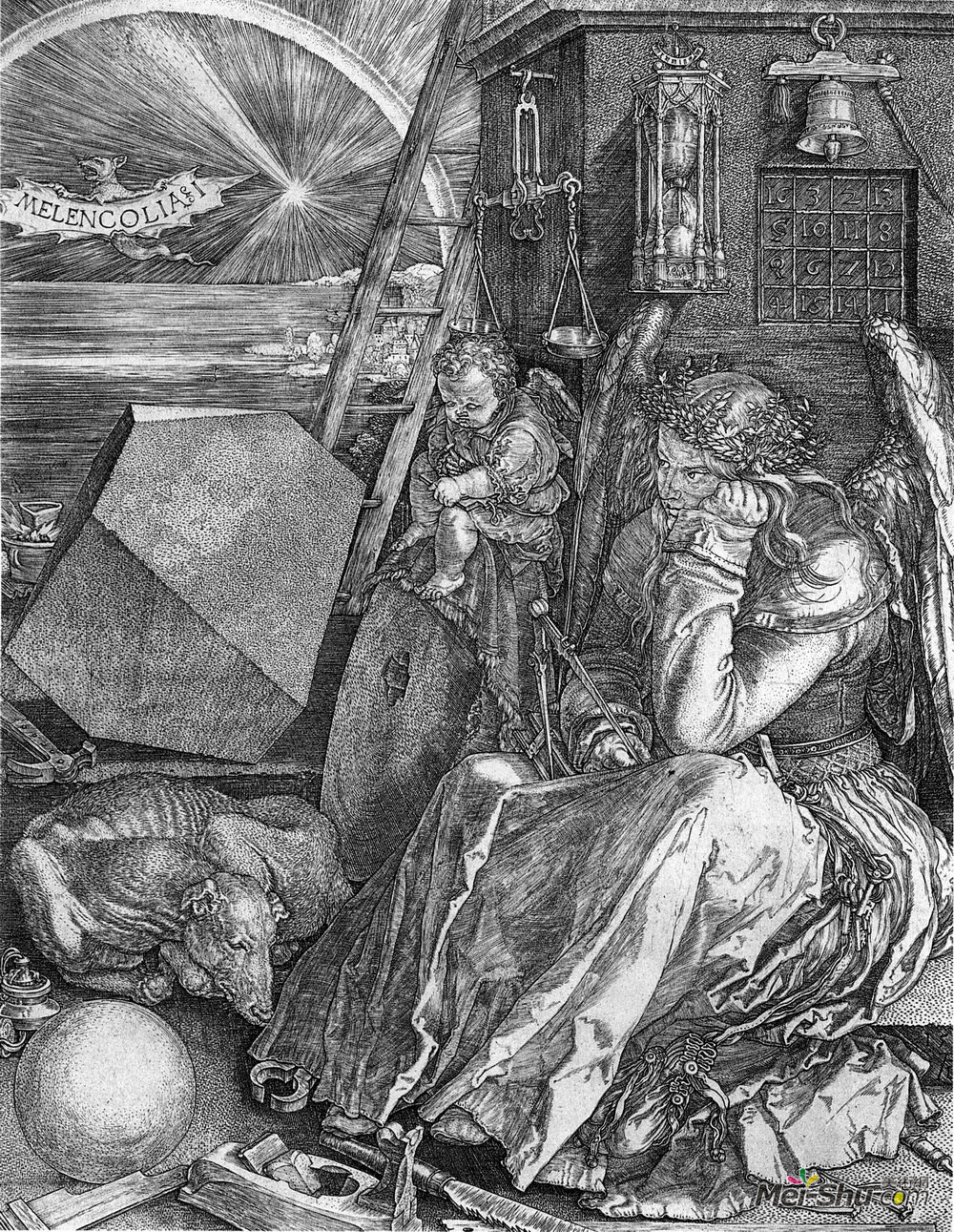 阿尔布雷希特·丢勒(Albrecht Durer)高清作品《梅伦科利亚一世》
阿尔布雷希特·丢勒(Albrecht Durer)高清作品《梅伦科利亚一世》
作品名:梅伦科利亚一世
艺术家:阿尔布雷希特·丢勒
年代:1514
风格:北欧文艺复兴
类型:寓言画
介质:雕刻
标签:寓言和符号,天使和天使
尺寸:18.8 x 24 cm
收藏:Kupferstichkabinett柏林,柏林,德国
我是1513个和三个大印记中的一个,被称为他的MeistelSiste(大师雕刻)。另外两个是骑士,死亡,魔鬼和Saint Jerome在他的研究中。这三者绝不是一个系列,但它们确实与中世纪经院哲学的三种美德——道德、神学和知识——相对应,它们体现了杜勒思想及其时代的复杂性。因此,这就是德鲁尔的精神自画像。在中世纪的哲学中,人们认为每个人主要受四种幽默中的一种所支配;忧郁,与黑胆病联系在一起,是四种幽默中最不受欢迎的,忧郁症患者被认为最有可能屈服于精神错乱。然而,文艺复兴时期的思想也把忧郁和创造天才联系在一起,因此,在改变这种幽默状态的同时,它使有自我意识的艺术家意识到他的礼物带有可怕的风险。她手里拿着卡钳,周围环绕着其他与几何学相关的工具,几何学是构成艺术创作基础的七门文科之一,而杜勒,或许比大多数艺术家都更希望通过这门文科在自己的作品中达到完美。一篇有影响力的论文,内特谢姆的科尼利厄斯·阿格里帕的《德奥秘哲学》,几乎可以肯定地为杜勒所知,可能对标题中的数字I有解释:艺术中的创造力是想象力的领域,被认为是第四世界等级中第一和最低的。天才的REE分类。其次是理性的境界,最高境界的精神。具有讽刺意味的是,艺术家瘫痪和无能为力的形象体现了杜勒自身艺术力量的最高峰。
Title:Melencolia I
artist:Albrecht Durer
Date:1514
Style:Northern Renaissance
Genre:allegorical painting
Media:engraving
Tag:allegories-and-symbols,angels-and-archangels
Dimensions:18.8 x 24 cm
Location:Kupferstichkabinett Berlin, Berlin, Germany
Dürer's Melencolia I is one of three large prints of 1513 and 1514 known as his Meisterstiche (master engravings). The other two are Knight, Death, and the Devil and Saint Jerome in His Study. The three are in no way a series, but they do correspond to the three kinds of virtue in medieval scholasticism--moral, theological, and intellectual--and they embody the complexity of Dürer's thought and that of his age.Melencolia I is a depiction of the intellectual situation of the artist and is thus, by extension, a spiritual self-portrait of Dürer. In medieval philosophy each individual was thought to be dominated by one of the four humors; melancholy, associated with glack gall, was the least desirable of the four, and melancholics were considered the most likely to succumb to insanity. Renaissance thought, however, also linked melancholy with creative genius; thus, at the same time that this idea changed the status of this humor, it made the self-conscious artist aware that his gift came with terrible risks.The winged personification of Melancholy, seated dejectedly with her head reasting on her hand, holds a caliper and is surrounded by other tools associated with geometry, the one of the seven liberal arts that underlies artistic creation--and the one through which Dürer, probably more than most artists, hoped to approach perfection in his own work. An influential treatise, the De Occulta Philosophia of Cornelius Agrippa of Nettesheim, almost certainly known to Dürer, probably holds the explanation for the number I in the title: creativity in the arts was the realm of the imagination, considered the first and lowest in the hierarchy of the three categories of genius. The next was the realm of reason, and the highest the realm of spirit. It is ironic that this image of the artist paralyzed and powerless exemplifies Dürer's own artistic power at its superlative height.
作品名称:《梅伦科利亚一世》阿尔布雷希特·丢勒(Albrecht Durer)高清作品欣赏
作品链接:https://www.mei-shu.com/famous/27327/artistic-118080.html
作品类别:油画
免责声明:本站部分公开资料来源于互联网,目的是用于学术交流与讨论,并不代表本网赞同其观点和对其真实性负责。如果您认为我们的侵犯了您的权益,请与我们联系(banquan#mei-shu.com #替换为@),我们将在第一时间删除相关内容。